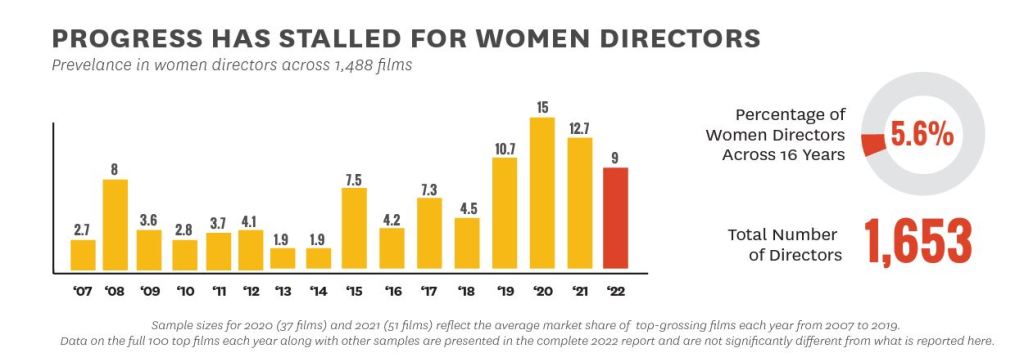A pair of studies released Monday from San Diego State’s annual The Celluloid Ceiling report and USC’s Annenberg Inclusion Initiative showed few gains for women and people of color working in the film industry in 2022.
In the SDSU study (read it here), which has tracked women’s employment on the 250 top-grossing films for the past 25 years, this year’s findings reveal that 11% of directors of 2022’s 100 top-grossing domestic films were women, down 1% year-over-year. Among the top 250 films, that number rose to 18%, up 1%.
Overall, women comprised 24% of all directors, writers, executive producers, editors and cinematographers working on the 250 top-grossing films of 2022, a 1% decline from 2021. In 1998, the first year of the Celluloid Ceiling report, that number was 17%.
Source: The Celluloid Ceiling: Employment of Behind-The-Scenes Women On Top Grossing U.S. Films in 2022
Among 2022’s top 250 films, the report found, women comprised 19% of writers, 25% of executive producers, 31% of producers, 21% of editors, and 7% of cinematographers. But that meant 93% of those films had no women cinematographers, 91% had no women composers, 80% had no women directors, 75% had no women editors, and 70% had no women writers.
“On a positive note, the study found that films with at least one woman director employed substantially more women in other key behind-the-scenes roles than films with exclusively male directors,” wrote Dr. Martha M. Lauzen, founder and executive director for SDSU’s Center for the Study of Women in Television and Film. “For example, on films with at least one woman director, women comprised 53% of writers and 39% of editors. On films with male directors, women accounted for 12% of writers and 19% of editors. These are non-trivial differences.”
The USC study (read it here), entitled “Inclusion in the Directors Chair,” looked at the number of women and underrepresented directors in the top-grossing films from 2007 to 2022. In 2022, it counted 9% of the 100 top-grossing film directors were women, down from 12.7% in 2021. Among women of color, only 2.7% of top-grossing directors were women; that percentage falls to 1.3% over the past 16 years.

Source: Inclusion in the Director’s Chair: Analysis of Director Gender and Race/Ethnicity Across the 1,600 Top Films from 2007 to 2022
USC also found that the percentage of directors from underrepresented racial/ethnic groups dipped to 20.7%, 6.6 percentage points behind 2021, when that figure reached a 15-year high. Overall, 15.2% of directors across 16 years were from underrepresented groups, while the proportional representation to the U.S. population is 40.7%.
“These figures make little sense in light of another study finding,” he study says, “that films by underrepresented directors earned roughly the same average Metacritic scores as movies from white directors.”
The report did highlight several major and mini-major distributors that stood out for employing women and underrepresented directors, notably Universal and Sony; the latter had five women directors (two people of color) working on its top films in 2022. Lionsgate and STX were lauded for their long-term efforts across the study’s 16-year time frame.
“Five years after #MeToo exploded and two years following the murder of George Floyd, Hollywood has evidenced little change for women and underrepresented directors—particularly women of color,” said Dr. Stacy L. Smith, a USC associate professor of communication and founder of the Annenberg Inclusion Initiative. “Donna Langley continues to lead the film industry by ensuring that Universal Pictures has established a track record for inclusion over the last 16 years, but film distributors and studios as a whole must do more to advance inclusion in this critical behind-the-scenes role. Perhaps executives should embrace a mentality described by Taylor Swift: ‘it’s me, I’m the problem.’”

